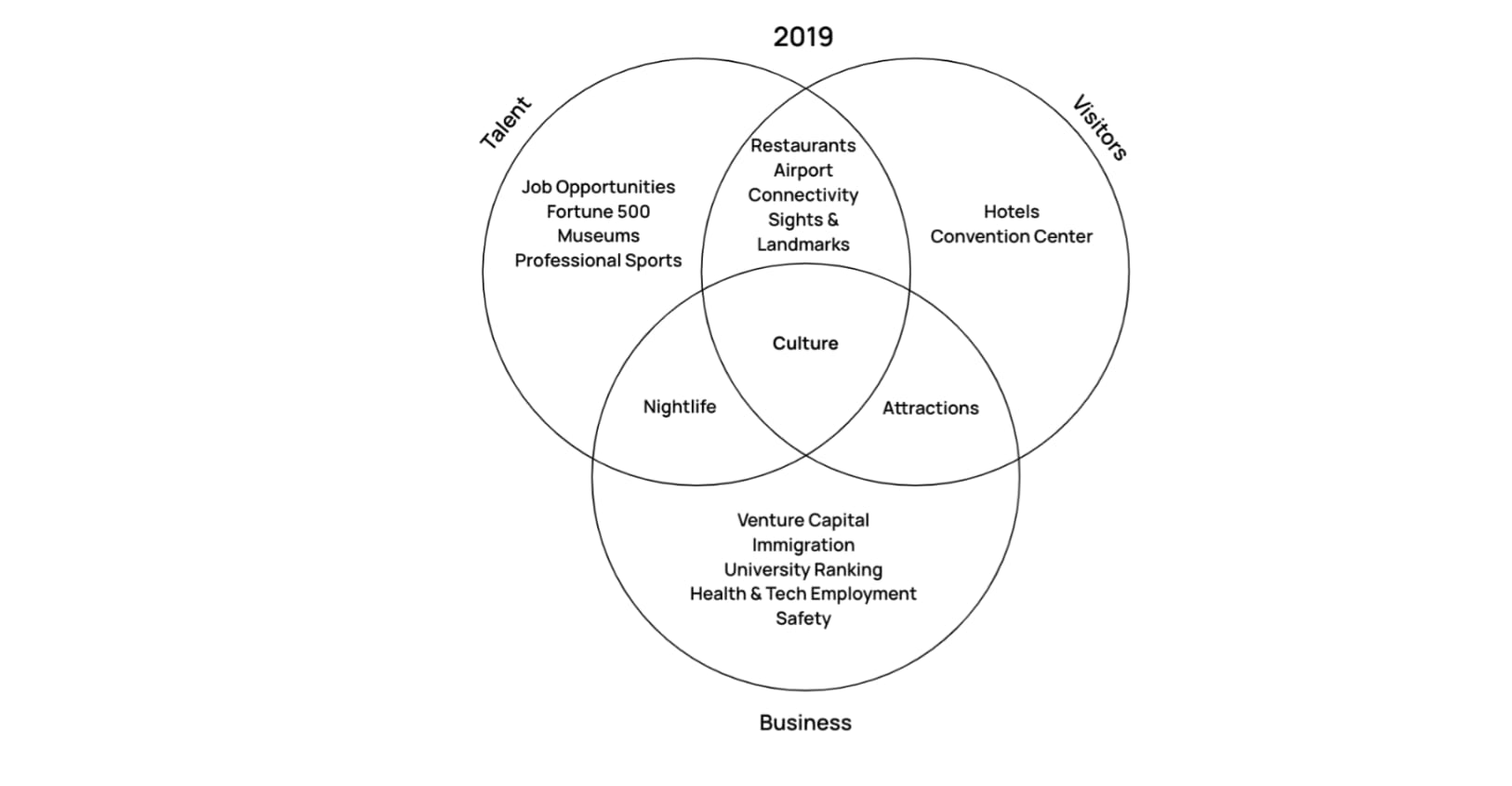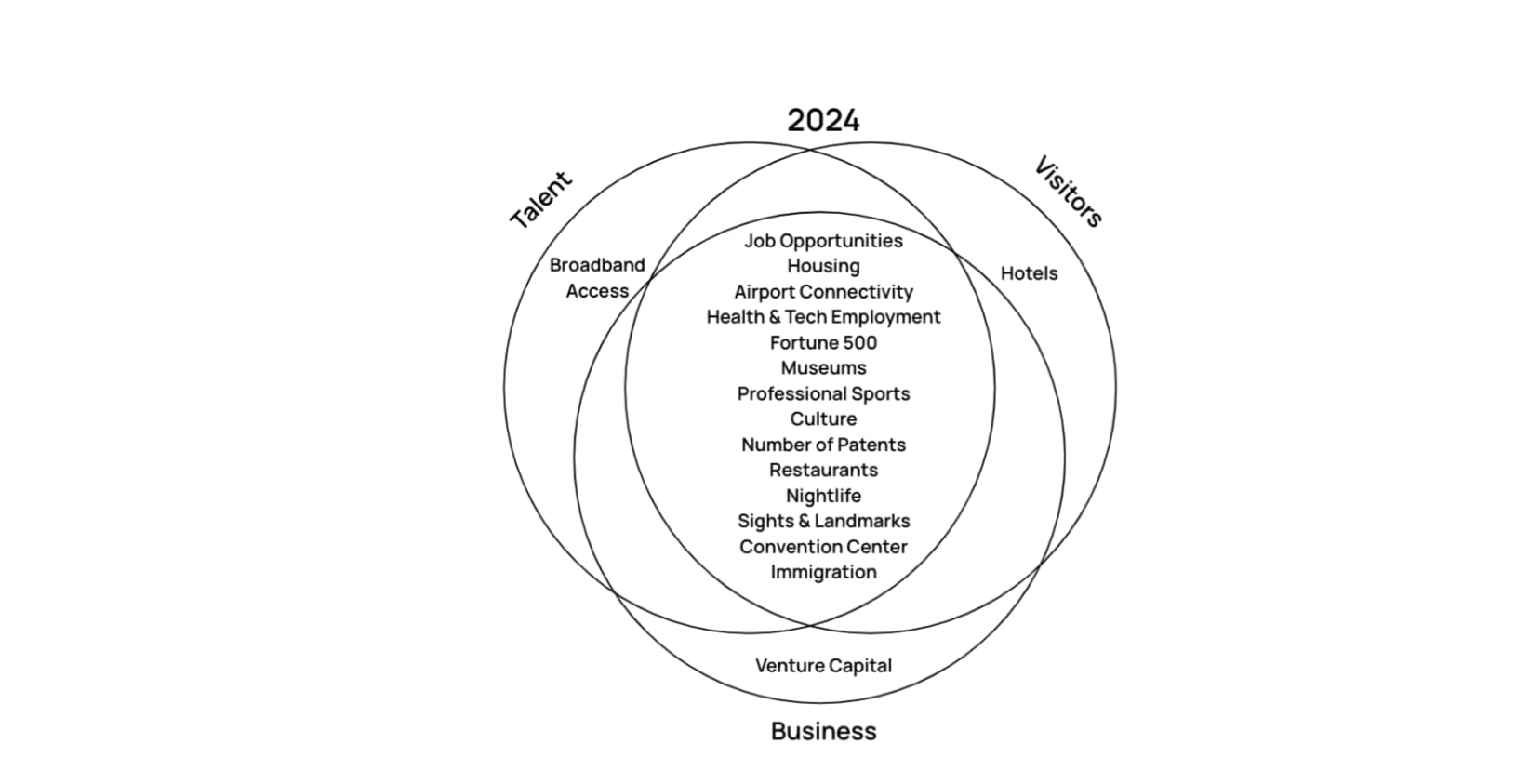Keys to the success of cities now
As City Nation Place celebrates ten years of connecting place branding professionals from around the world, we reached out to long-term partner Chris Fair, President & CEO of Resonance Consultancy and sponsor of the very first City Nation Place event, to discover how he believes the world of place branding has evolved over the past decade.
This time exactly 10 years ago was a formative period for my place branding journey, and the trajectory of Resonance. In 2014, my place branding consultancy not only became one of the first sponsors of an upstart conference called City Nation Place, but Resonance also went all-in on an ambitious project to create a new approach to benchmarking the performance of places by identifying the factors most highly correlated with business formation, talent attraction, and visitor expenditure in our cities.
Since then, Resonance has not only analysed hundreds of data points from traditional sources such as Eurostat, the UN, and the U.S. Bureau of Labor Statistics, but we have also mined user-generated data from online sources such as Google, Tripadvisor, and Instagram. This research led to the creation of Resonance’s annual Best Cities rankings, which are now read by millions of people around the world, and our proprietary Place Power© Score that we apply in all of our client work.
Prior to the pandemic, our research showed that there were a variety of different factors highly correlated with the size of a city’s prime age population (age 25 – 44), visitor expenditure, and the number of businesses formed each year. As the figure below illustrates, some of these overlapped with one another such as restaurants, airport connectivity, and sights and landmarks, which showed a relationship both with talent and visitor expenditure. Others, like nightlife, showed a relationship with both business formation and talent attraction, while culture showed a strong positive relationship with all three.

In preparing our upcoming 2024 America’s Best Cities report (out mid-June, 2024 at WorldsBestCities.com), we’ve gone back and updated this analysis of metropolitan areas in the U.S. with populations of 500,000 or more.
The findings are striking.
Most of the factors are similar to what we saw in 2019, but a strong convergence has developed between the factors most highly correlated with talent attraction, business formation, and visitor expenditure.
And this may be the most significant and lasting effect of the pandemic: Now that people can go or live almost anywhere, they want to go, live, or start a business somewhere. And, as a result, the keys to attracting talent, businesses, and visitors to the city have become more aligned with one another than ever before.

Based on our analysis of U.S. metropolitan areas with populations of 500,000 or more, here are our 10 key findings on what’s driving the performance and prosperity of cities now.
1. Innovation
It’s not surprising to see that the number of professional, scientific, and technical enterprises in a metro area has an almost linear correlation with the number of businesses being formed each year in a city. We also see an almost linear correlation between the number of these enterprises and the size of a city’s prime-age population—the people that power and drive innovation in our urban economies.
2. Connectivity
While Zoom and Teams have replaced a significant amount of business travel, airports and the number of direct destinations they serve still play a critical role in shaping the prosperity of the city. Of course they help power the visitor economy, too, but they have an even stronger relationship with attracting talent. Young people want to live in cities well connected to other cities.
3. Housing
In the past, we have been unable to demonstrate a clear relationship between the cost of housing and attracting talent—talent tended to move to places where housing was expensive because that’s where the best job opportunities were. But that has now changed. The average rent of an apartment is now showing not only a relationship with the size of a city’s prime-age population, but with business formation and visitor expenditure as well. As the cost of housing has escalated in cities both large and small, it seems that we’ve reached a tipping point where the availability and affordability of housing has truly started to affect location decisions.
4. Culture
For years now, we have used our research to discuss how factors like museums, concert venues, nightlife, and restaurants shape a city’s “lovability” and why they are important to attracting both visitors and talent to a city. That hasn’t changed, but these cultural factors now also show a very strong correlation with the number of businesses being formed in a city each year as well. The stronger the cultural offering in a city, the more businesses are being created. And no experiential factor stands out more than the importance of restaurants and a city’s culinary scene when it comes to attracting and retaining prime-age talent.
5. Corporate Headquarters
An HQ presence drives visitor expenditure as well (although that may be declining with reduced business travel). We are also seeing a strong relationship between the number of large corporate headquarters and cost of living-adjusted earnings in a city—jobs at large corporations tend to offer better pay to compete with higher costs of living.
6. Diversity
Immigration and the foreign-born population of a city has an important relationship with not only business formation but talent attraction and retention as well. The correlation between immigration and business formation also points to the importance of strong small business ecosystems within cities from an equity lens for these families to generate wealth. Immigrants also help drive inbound and outbound travel to visit friends and relatives, an important driver of air-route development and connectivity for a city’s airport.
7. Professional Sports
Investment of public dollars to fund arenas and stadiums has always been contentious. The recently announced $500 million in funding to keep the NBA’s Washington Wizards and NHL’s Capitals in Washington DC is just the most recent example. Irrespective of where we stand on that debate, we do see a clear relationship between the number of professional sports franchises located in a city and the size of its prime-age population, dollars spent by visitors, and the number of businesses being formed each year.
8. Sights & Landmarks
As visitors, we want to travel to places with things to see and do and it should come as no surprise that the number of sights and landmarks in a city has a strong relationship with the size of its visitor economy. But sights and landmarks also have a strong relationship with the size of a city’s prime-age population and the strength of its start-up economy. This is yet another piece of evidence of the increasing alignment between tourism and economic development for cities.
9. Convention Centers
The relationship between the size of a city’s convention center and the level of visitor spending in a city is probably well understood. What’s less appreciated is the relationship between convention centers and economic development. Convention centers not only support the visitor economy, but have a relationship with the number of businesses being formed in a city as well. They also often host as many or more shows and events for the local community as they do for visitors.
10. Parks & Outdoor Activities
Our interest and participation in outdoor sports and activities soared during the pandemic. While the number of parks and outdoor activities do not show a strong relationship with the relative prosperity of a city, access to green space and outdoor recreation is an important driver of livability and quality of life for residents and appears to be of moderate importance when it comes to attracting and retaining both talent and visitors to a city.
This convergence of these factors when it comes to talent attraction, business formation and visitor expenditure speaks to the need to develop more integrated positioning and marketing strategies between city administrators, destination marketing, and economic development organisations. Their objectives and target audiences may be different, but the keys to realising those objectives have become increasingly aligned. A growing number of cities and regions are realizing the need to develop a better aligned civic identity.
We look forward to studying and seeing how the perception and performance of places evolves from here in the decade ahead. And sharing our findings, insights and work with the City Nation Place community for another 10 years!
If you would like to learn more, I’d love to chat:
Chris Fair, President & CEO, Resonance
cfair@resonanceco.com









